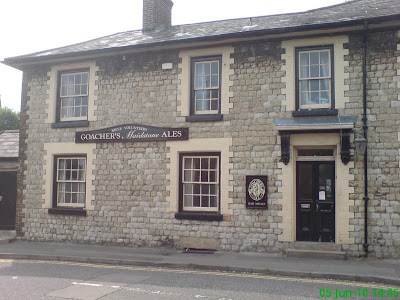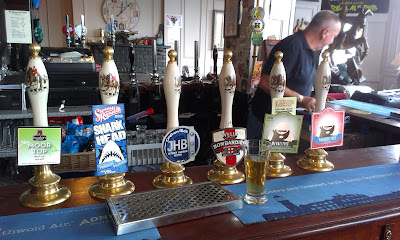It’s difficult to know where to start with this one, as the
subject matter has many inter-woven threads, and the post could end up being
a long one. I’m keen to avoid this
happening, so I’ll do my utmost to stay on topic, which just happens to be that perennial
favourite – the CAMRA Good Beer Guide.
Regular readers will probably know I haven’t bought the
Guide for some years, although that could change when I activate the App on my
phone. But even without an up to date edition I can see a pattern emerging as
the 45 year old publication continues to evolve.
From reading various blogs, and also talking to regular
users of the Guide, it is evident that entries have changed over the past few
years; certainly from when I last bought a copy. Not that long ago,
Wetherspoon’s were very much in vogue, with many branches putting forward their
local Spoon’s as an entry in the guide. A few years later, JDW outlets had
become less common and micro-pubs were all the rage, and I believe that to a
certain extent, they still are.

Now it is the turn of the brewery-tap. When talking about a
tap, I’m not referring to what us older drinkers would think of as a
“brewery
tap” ie. the nearest pub to the brewery. Many people have fond memories of pubs
like the
Ram Inn, which was the
“tap” for the adjacent, but now sadly closed
Ram Brewery of Young & Co, or the
George & Devonshire, which is the
“tap” for the
happily still thriving
Fuller’s
Brewery next door.
Instead I am alluding to the increasing number of
independent brewery taprooms, particularly in
London, where the brewery’s
beers (keg as well as cask), can be sampled and enjoyed in the confines of the
brewery or adjacent bar.

With these changes many would argue that the
GBG is sticking
to its roots by remaining as a
Good Beer Guide (as stated on the cover),
rather than as others see it; a
Good Pub Guide. So far so good, but from what's been pieced together so far, along with my own experiences, this focus on beer
has led to the
Guide being described, somewhat unfairly, as the
Good GUEST Beer
Guide.
There is a suspicion amongst certain beer writers that pubs
are being selected purely on the basis that they offer a wide range of, often
obscure, beers rather than on the over-riding factor of beer quality. Several
have complained that pubs are now deliberately stocking more beers than they
are capable of turning over, in order to secure a place in the GBG.
In contrast, those pubs adopting a more sensible and
realistic approach to stocking are being left out in the cold. This seems
particularly applicable to pubs tied to one of the surviving family brewers,
which serve just one or two beers.
There are obviously no winners here, especially with in the
case of over-stocking, as one or two of the less popular beers will inevitably
stick around longer than they should. The quality obviously suffers, and as no
one likes a duff pint, people end up voting with their feet. The one or two beer outlets also feel
disadvantaged, even though they are doing the right thing.
Irrespective of whether these stories are true, many in the
licensed trade believe that stocking a wide range of beers is the key to
securing a place in the Good Beer Guide,
despite various denials from CAMRA. However, if certain CAMRA branches
are doing this, they are doing themselves and the organisation as a whole no
favours at all. They are not helping the pub trade either.

The perception that
CAMRA favours multi-beer pubs over
single beer ones, must have some basis in fact; although whether it is reality,
is a different matter. The growing number of reports about indifferent or
downright poor quality beer in many of these
“beer exhibition” type pubs is
cause for concern though, and certainly does little to promote cask ale as the drink
of choice in the nation’s pubs.
I feel that this one is going to run and run, so I’ll leave it there
for the moment, and just touch briefly on a couple of other criticisms
concerning the Good Beer Guide at the present.
The most serious is that of pubs not adhering to their
published opening hours; an extremely frustrating and annoying experience, when
a visitor has travelled a long way, only to find a particular pub shut. This
seems to occur mainly at lunchtimes or in the afternoon; the very sessions that
are most practical, and most appealing, to travellers from afar.
These annoyances are probably due to the lengthy intervals
between the initial survey for the guide, and its eventual appearance in print.
For example, branches are currently surveying pubs for the 2019 Good Beer
Guide, even though it won’t appear in print until next autumn.

One way to speed up the production process, and thereby
improve the accuracy of entries, would be to eliminate the
“Breweries Section”
in the back of the
Guide. This bulky and increasingly superfluous section
occupies a large chunk of the
GBG and takes ages to compile. It’s very presence
is the other major criticism put forward by many commentators.
The list of all the UK’s
breweries, along with the beers they produce, did once form an essential part
of the Guide, but as the number of breweries has increased nearly tenfold over
the GBG’s 45 year existence, so its usefulness has diminished.

Virtually every brewery, including the proverbial
“ man in a
shed”, has a website capable of being updated far more regularly than
the
GBG, and containing far more information about a brewery’s products than
anything the
Guide could contain; so why the continuing need for this waste of
wood pulp?
Things move extremely slowly within CAMRA, and despite the
recent stepping down of Roger Protz, as the Good Beer Guide’s long serving
editor, we are unlikely to see any change until 2020 at the earliest.
In a rapidly changing world, the GBG really needs to adapt
in order to survive, and it may end up having to redefine itself. Despite protestations
that it is what it says on the cover – a Good BEER Guide, many of the people
who buy it see it as a guide to good pubs which also happen to serve good beer.
Life was much simpler back in 1974 when the Good Beer Guide
first launched, and it was an indispensable guide to somewhere serving an
unadulterated pint of good cask ale, in a sea of cold, fizzy and invariably
tasteless keg offerings. Good beer is everywhere now and so CAMRA, as the
Guide’s promoter, needs to look closely at the purpose and indeed the whole
raison d’etre of its flagship publication.










































